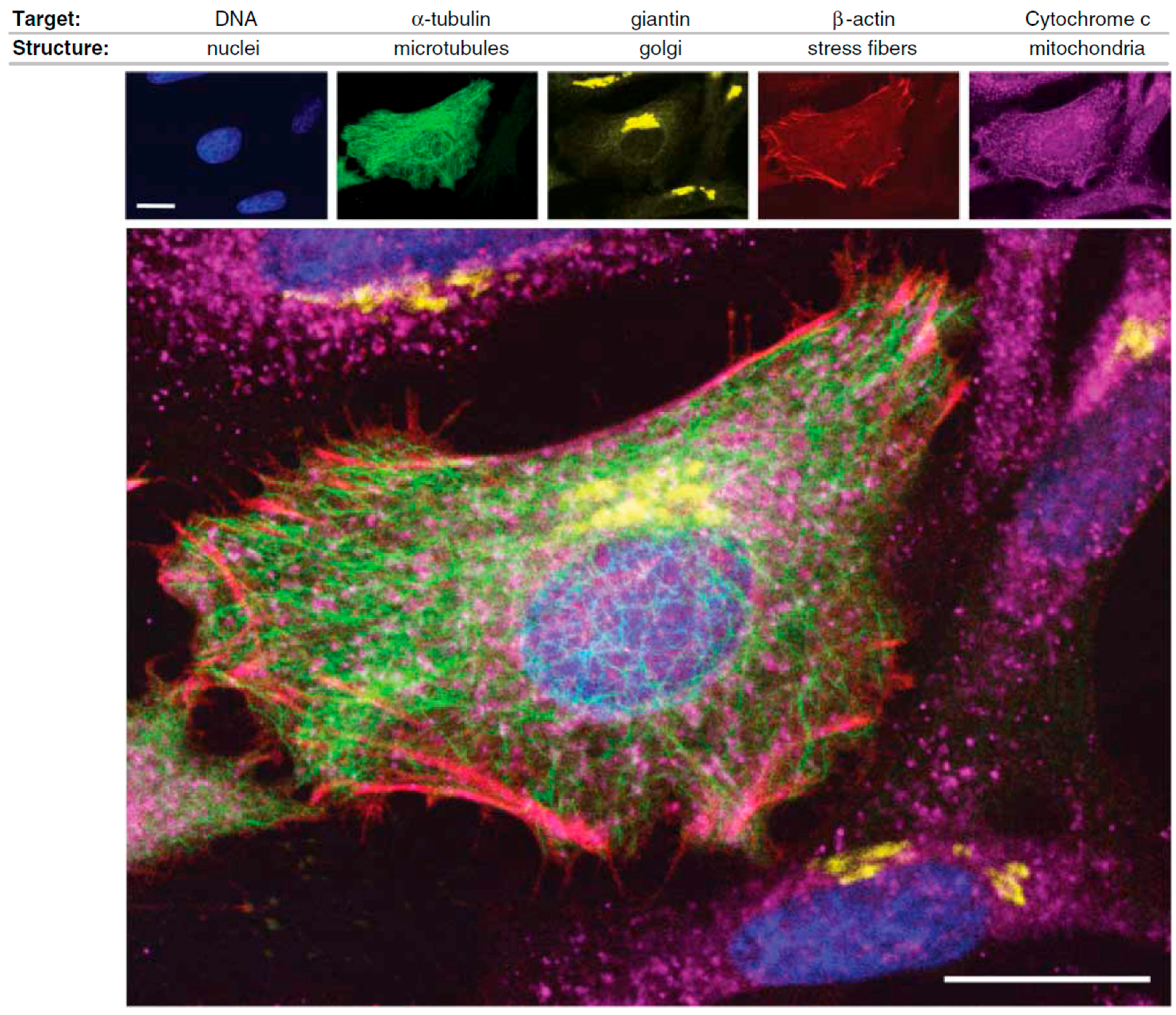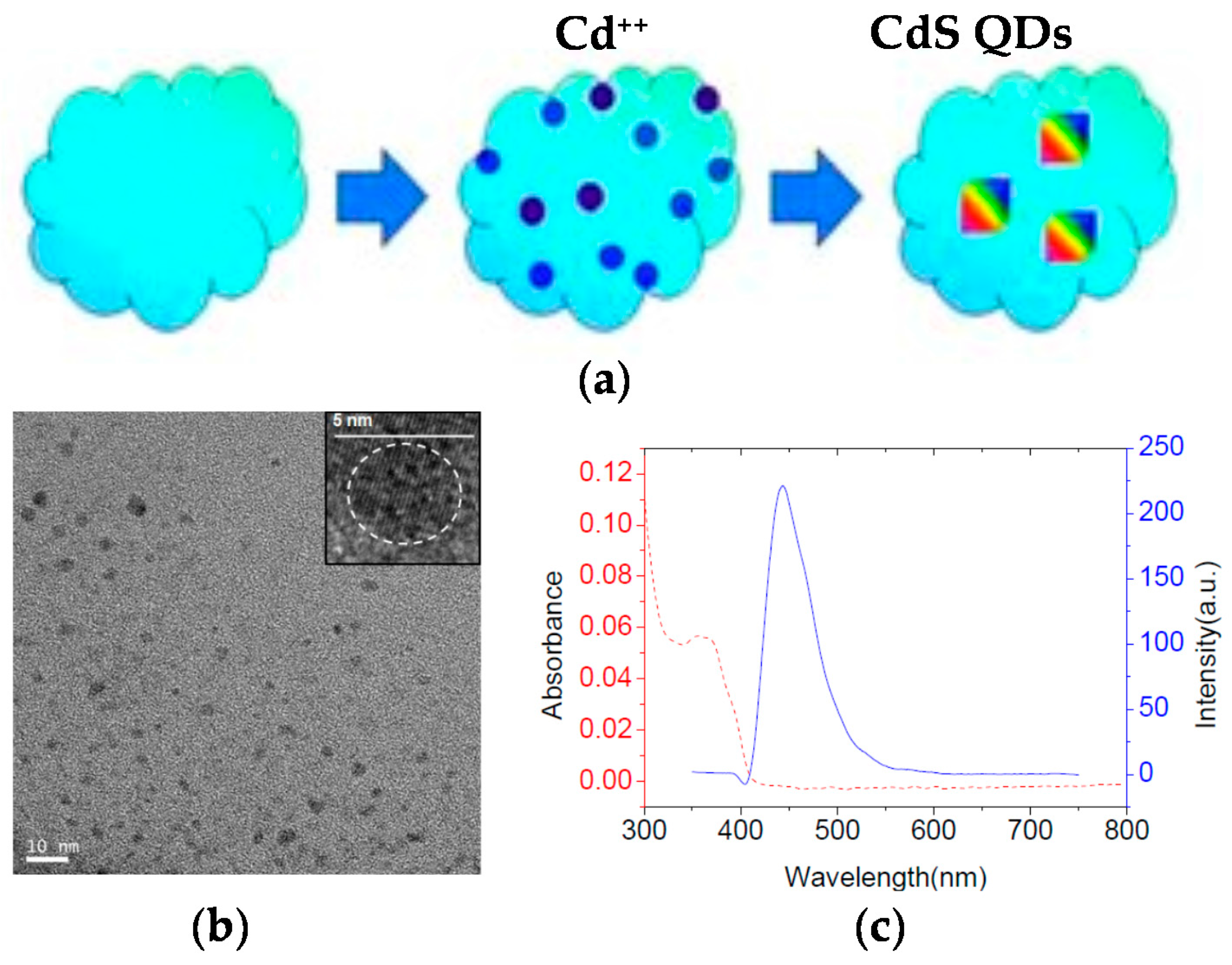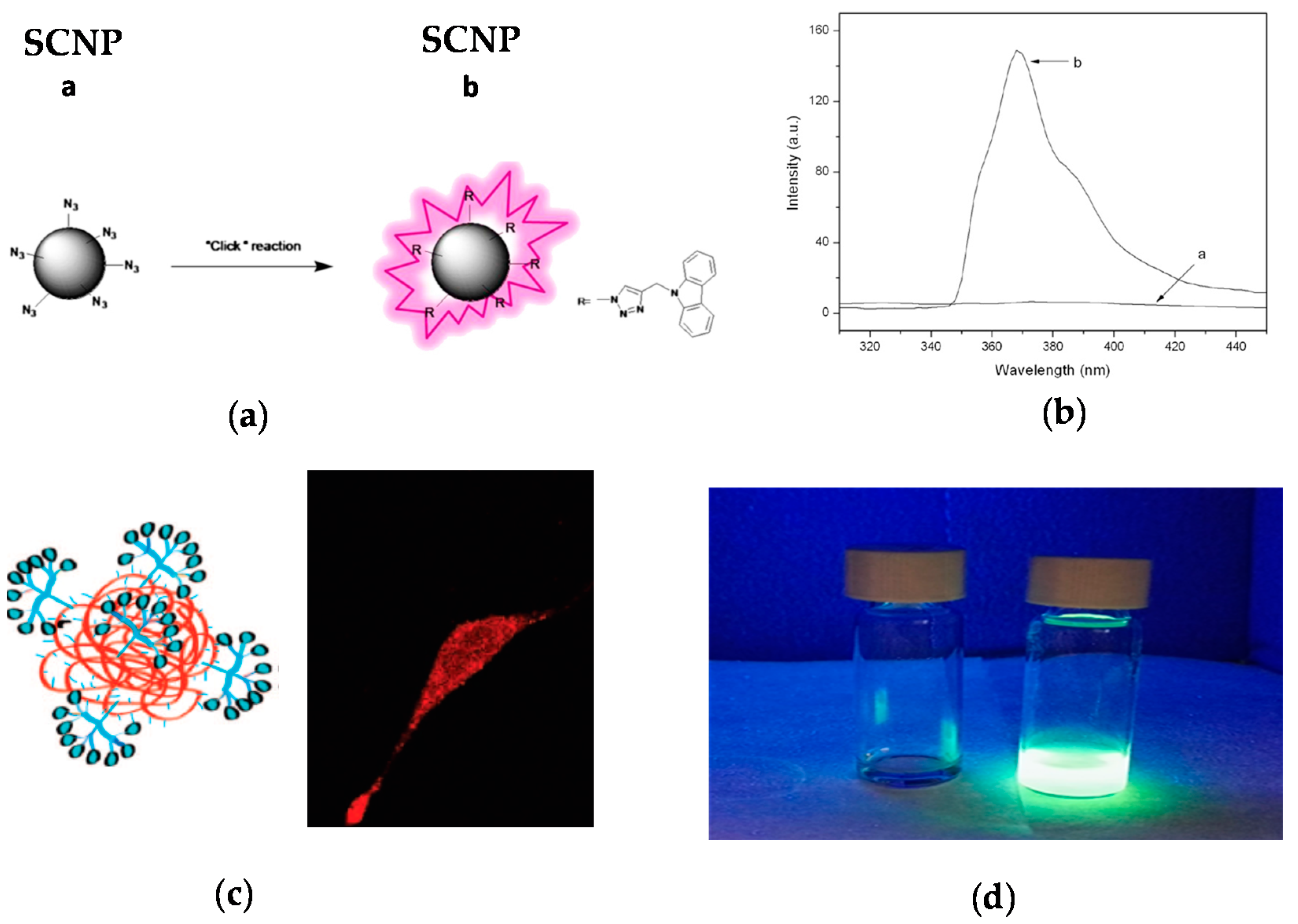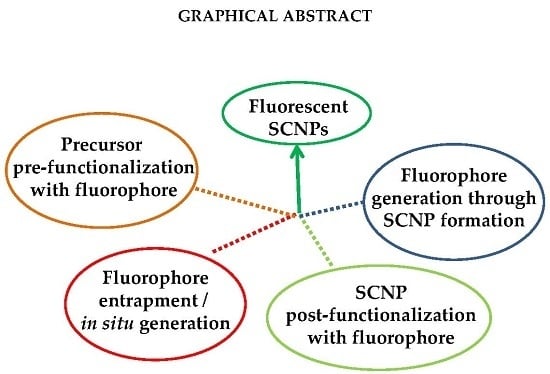Advances in Fluorescent Single-Chain Nanoparticles
Abstract
1. Introduction
2. Fluorescent Single-Chain Nanoparticles: Synthesis Routes
2.1. Precursor Pre-Functionalization with Fluorophore
2.2. Fluorophore Entrapment/In Situ Generation
2.3. SCNP Post-Functionalization with Fluorophore
2.4. Fluorophore Generation through SCNP Formation
3. Conclusions
Acknowledgments
Author Contributions
Conflicts of Interest
References
- Shi, J.; Kantoff, P.W.; Wooster, R.; Farokhzad, O.C. Cancer nanomedicine: Progress, challenges and opportunities. Nat. Rev. Cancer 2017, 17, 20–37. [Google Scholar] [CrossRef] [PubMed]
- Robin, M.P.; O’Reilly, R.K. Strategies for preparing fluorescently labelled polymer nanoparticles. Polym. Int. 2015, 64, 174–182. [Google Scholar] [CrossRef]
- Yildiz, I.; Impellizzeri, S.; Deniz, E.; McCaughan, B.; Callan, J.F.; Raymo, F.M. Supramolecular strategies to construct biocompatible and photoswitchable fluorescent assemblies. J. Am. Chem. Soc. 2011, 133, 871–879. [Google Scholar] [CrossRef] [PubMed]
- Swaminathan, S.; Fowley, C.; McCaughan, B.; Cusido, J.; Callan, J.F.; Raymo, F.M. Intracellular guest exchange between dynamic supramolecular hosts. J. Am. Chem. Soc. 2014, 136, 7907–7913. [Google Scholar] [CrossRef] [PubMed]
- Chen, F.; Ehlerding, E.B.; Cai, W. Theranostic nanoparticles. J. Nucl. Med. 2014, 55, 1919–1922. [Google Scholar] [CrossRef] [PubMed]
- Breul, A.M.; Hager, M.D.; Schubert, U.S. Fluorescent monomers as building blocks for dye labeled polymers: Synthesis and application in energy conversion, biolabeling and sensors. Chem. Soc. Rev. 2013, 42, 5366–5407. [Google Scholar] [CrossRef] [PubMed]
- Hudson, Z.M.; Lunn, D.J.; Winnik, M.A.; Manners, I. Colour-tunable fluorescent multiblock micelles. Nat. Commun. 2014, 5, 3372. [Google Scholar] [CrossRef] [PubMed]
- Robin, M.P.; Raymond, J.E.; O’Reilly, R.K. One-pot synthesis of super-bright fluorescent nanogel contrast agents containing a dithiomaleimide fluorophore. Mater. Horiz. 2015, 2, 54–59. [Google Scholar] [CrossRef]
- Michalet, X.; Pinaud, F.F.; Bentolila, L.A.; Tsay, J.M.; Doose, S.; Li, J.J.; Sundaresan, G.; Wu, A.M.; Gambhir, S.S.; Weiss, S. Quantum dots for live cells, in vivo imaging, and diagnostics. Science 2005, 307, 538–544. [Google Scholar] [CrossRef] [PubMed]
- Wu, C.; Chiu, D.T. Highly fluorescent semiconducting polymer dots for biology and medicine. Angew. Chem. Int. Ed. 2013, 52, 3086–3109. [Google Scholar] [CrossRef] [PubMed]
- Fuchs, S.; Otto, H.; Jehle, S.; Henklein, P.; Schlüter, A.D. Fluorescent dendrimers with a peptide cathepsin B cleavage site for drug delivery applications. Chem. Commun. 2005, 1830–1832. [Google Scholar] [CrossRef] [PubMed]
- Giepmans, B.N.G.; Adams, S.R.; Ellisman, M.H.; Tsien, R.Y. The fluorescent toolbox for assessing protein location and function. Science 2006, 312, 217–224. [Google Scholar] [CrossRef] [PubMed]
- Pomposo, J.A. (Ed.) Single-Chain Polymer Nanoparticles: Synthesis, Characterization, Simulations and Applications; Wiley-VCH: Weinheim, Germany, 2017. [Google Scholar]
- Pomposo, J.A.; Rubio-Cervilla, J.; Moreno, A.J.; Lo Verso, F.; Bacova, P.; Arbe, A.; Colmenero, J. Folding single chains to single-chain nanoparticles via reversible interactions: What size reduction can one expect? Macromolecules 2017, 50, 1732–1739. [Google Scholar] [CrossRef]
- De-La-Cuesta, J.; González, E.; Moreno, A.J.; Arbe, A.; Colmenero, J.; Pomposo, J.A. Size of elastic single-chain nanoparticles in solution and on surfaces. Macromolecules 2017, 50, 6323–6331. [Google Scholar] [CrossRef]
- Latorre-Sanchez, A.; Pomposo, J.A. Recent bioinspired applications of single-chain nanoparticles. Polym. Int. 2016, 65, 855–860. [Google Scholar] [CrossRef]
- Huo, M.; Wang, N.; Fang, T.; Sun, M.; Wei, Y.; Yuan, J. Single-chain polymer nanoparticles: Mimic the proteins. Polymer 2015, 66, A11–A21. [Google Scholar] [CrossRef]
- Pomposo, J.A. Bioinspired single-chain polymer nanoparticles. Polym. Int. 2014, 63, 589–592. [Google Scholar] [CrossRef]
- Perez-Baena, I.; Barroso-Bujans, F.; Gasser, U.; Arbe, A.; Moreno, A.J.; Colmenero, J.; Pomposo, J.A. Endowing single-chain polymer nanoparticles with enzyme-mimetic activity. ACS Macro Lett. 2013, 2, 775–779. [Google Scholar] [CrossRef]
- Sanchez-Sanchez, A.; Arbe, A.; Kholbrecher, J.; Colmenero, J.; Pomposo, J.A. Efficient synthesis of single-chain globules mimicking the morphology and polymerase activity of metalloenzymes. Macromol. Rapid Commun. 2015, 36, 1592–1597. [Google Scholar] [CrossRef] [PubMed]
- Gonzalez-Burgos, M.; Latorre-Sanchez, A.; Pomposo, J.A. Advances in single chain technology. Chem. Soc. Rev. 2015, 44, 6122–6142. [Google Scholar] [CrossRef] [PubMed]
- Mavila, S.; Eivgi, O.; Berkovich, I.; Lemcoff, N.G. Intramolecular cross-linking methodologies for the synthesis of polymer nanoparticles. Chem. Rev. 2016, 116, 878–961. [Google Scholar] [CrossRef] [PubMed]
- Hanlon, A.M.; Lyon, C.K.; Berda, E.B. What is next in single-chain nanoparticles? Macromolecules 2016, 49, 2–14. [Google Scholar] [CrossRef]
- Altintas, O.; Barner-Kowollik, C. Single-chain folding of synthetic polymers: a critical update. Macromol. Rapid Commun. 2016, 37, 29–46. [Google Scholar] [CrossRef] [PubMed]
- Lyon, C.K.; Prasher, A.; Hanlon, A.M.; Tuten, B.T.; Tooley, C.A.; Frank, P.G.; Berda, E.B. A brief user’s guide to single-chain nanoparticles. Polym. Chem. 2015, 6, 181–197. [Google Scholar] [CrossRef]
- Sanchez-Sanchez, A.; Pomposo, J.A. Single-chain polymer nanoparticles via non-covalent and dynamic covalent bonds. Part. Part. Syst. Charact. 2014, 31, 11–23. [Google Scholar] [CrossRef]
- Müge, A.; Elisa, H.; Meijer, E.W.; Anja, R.A.P. Dynamic single chain polymeric nanoparticles: From structure to function. In Sequence-Controlled Polymers: Synthesis, Self-Assembly, and Properties; American Chemical Society: Washington, DC, USA, 2014; Volume 1170, pp. 313–325. [Google Scholar]
- Sanchez-Sanchez, A.; Perez-Baena, I.; Pomposo, J.A. Advances in click chemistry for single-chain nanoparticle construction. Molecules 2013, 18, 3339–3355. [Google Scholar] [CrossRef] [PubMed]
- Altintas, O.; Barner-Kowollik, C. Single chain folding of synthetic polymers by covalent and non-covalent interactions: Current status and future perspectives. Macromol. Rapid Commun. 2012, 33, 958–971. [Google Scholar] [CrossRef] [PubMed]
- Aiertza, M.; Odriozola, I.; Cabañero, G.; Grande, H.-J.; Loinaz, I. Single-chain polymer nanoparticles. Cell. Mol. Life Sci. 2012, 69, 337–346. [Google Scholar] [CrossRef] [PubMed]
- Harth, E.; Horn, B.V.; Lee, V.Y.; Germack, D.S.; Gonzales, C.P.; Miller, R.D.; Hawker, C.J. A facile approach to architecturally defined nanoparticles via intramolecular chain collapse. J. Am. Chem. Soc. 2002, 124, 8653–8660. [Google Scholar] [CrossRef] [PubMed]
- Mecerreyes, D.; Lee, V.; Hawker, C.J.; Hedrick, J.L.; Wursch, A.; Volksen, W.; Magbitang, T.; Huang, E.; Miller, R.D. A novel approach to functionalized nanoparticles: Self-crosslinking of macromolecules in ultradilute solution. Adv. Mater. 2001, 13, 204–208. [Google Scholar] [CrossRef]
- Wang, P.; Pu, H.; Ge, J.; Jin, M.; Pan, H.; Chang, Z.; Wan, D. Fluorescence-labeled hydrophilic nanoparticles via single-chain folding. Mater. Lett. 2014, 132, 102–105. [Google Scholar] [CrossRef]
- Adkins, C.T.; Dobish, J.N.; Brown, S.; Harth, E. Water-soluble semiconducting nanoparticles for imaging. ACS Macro Lett. 2013, 2, 710–714. [Google Scholar] [CrossRef] [PubMed]
- Adkins, C.T.; Muchalski, H.; Harth, E. Nanoparticles with individual site-isolated semiconducting polymers from intramolecular chain collapse processes. Macromolecules 2009, 42, 5786–5792. [Google Scholar] [CrossRef]
- Bai, Y.; Xing, H.; Vincil, G.A.; Lee, J.; Henderson, E.J.; Lu, Y.; Lemcoff, N.G.; Zimmerman, S.C. Practical synthesis of water-soluble organic nanoparticles with a single reactive group and a functional carrier scaffold. Chem. Sci. 2014, 5, 2862–2868. [Google Scholar] [CrossRef]
- Blasco, E.; Yameen, B.; Quick, A.S.; Krolla-Sidenstein, P.; Welle, A.; Wegener, M.; Barner-Kowollik, C. Designing π-conjugated polymeric nano- and microstructures via light induced chemistry. Macromolecules 2016, 48, 8718–8728. [Google Scholar] [CrossRef]
- Song, C.; Li, L.; Dai, L.; Thayumanavan, S. Responsive single-chain polymer nanoparticles with host-guest features. Polym. Chem. 2015, 6, 4828–4834. [Google Scholar] [CrossRef]
- Liu, Y.; Pauloehrl, T.; Presolski, S.I.; Albertazzi, L.; Palmans, A.R.A.; Meijer, E.W. Modular synthetic platform for the construction of functional single-chain polymeric nanoparticles: From aqueous catalysis to photosensitization. J. Am. Chem. Soc. 2015, 137, 13096–13105. [Google Scholar] [CrossRef] [PubMed]
- Akagi, T.; Piyapakorn, P.; Akashi, M. Formation of unimer nanoparticles by controlling the self-association of hydrophobically modified poly(amino acid)s. Langmuir 2012, 28, 5249–5256. [Google Scholar] [CrossRef] [PubMed]
- Piyapakorn, P.; Akagi, T.; Hachisuka, M.; Onishi, T.; Matsuoka, H.; Akashi, M. Structural analysis of unimer nanoparticles composed of hydrophobized poly(amino acid)s. Macromolecules 2013, 46, 6187–6194. [Google Scholar] [CrossRef]
- Bai, Y.; Feng, X.; Xing, H.; Xu, Y.; Kim, B.K.; Baig, N.; Zhou, T.; Gewirth, A.A.; Lu, Y.; Oldfield, E.; et al. A highly efficient single-chain metal-organic nanoparticle catalyst for alkyne-azide “Click” reactions in water and in cells. J. Am. Chem. Soc. 2016, 138, 11077–11080. [Google Scholar] [CrossRef] [PubMed]
- Qian, G.; Zhu, B.; Wang, Y.; Deng, S.; Hu, A. Size-tunable polymeric nanoreactors for one-pot synthesis and encapsulation of quantum dots. Macromol. Rapid Commun. 2012, 33, 1393–1398. [Google Scholar] [CrossRef] [PubMed]
- Zhu, B.; Sun, S.; Wang, Y.; Deng, S.; Qian, G.; Wang, M.; Hu, A. Preparation of carbon nanodots from single chain polymeric nanoparticles and theoretical investigation of the photoluminescence mechanism. J. Mater. Chem. C 2013, 1, 580–586. [Google Scholar] [CrossRef]
- Li, G.; Tao, F.; Wang, L.; Li, Y.; Bai, R. A facile strategy for preparation of single-chain polymeric nanoparticles by intramolecular photo-crosslinking of azide polymers. Polymer 2014, 55, 3696–3702. [Google Scholar] [CrossRef]
- Hamilton, S.K.; Harth, E. Molecular dendritic transporter nanoparticle vectors provide efficient intracellular delivery of peptides. ACS Nano 2009, 3, 402–410. [Google Scholar] [CrossRef] [PubMed]
- González-Burgos, M.; Alegría, A.; Arbe, A.; Colmenero, J.; Pomposo, J.A. An unexpected route to aldehyde-decorated single-chain nanoparticles from azides. Polym. Chem. 2016, 7, 6570–6574. [Google Scholar] [CrossRef]
- Jiang, J.; Thayumanavan, S. Synthesis and characterization of amine-functionalized polystyrene nanoparticles. Macromolecules 2005, 38, 5886–5891. [Google Scholar] [CrossRef]
- Ruiz de Luzuriaga, A.; Ormategui, N.; Grande, H.J.; Odriozola, I.; Pomposo, J.A.; Loinaz, I. Intramolecular click cycloaddition: An efficient room-temperature route towards bioconjugable polymeric nanoparticles. Macromol. Rapid Commun. 2008, 29, 1156–1160. [Google Scholar] [CrossRef]
- Zhang, Y.; Zhao, H. Surface-tunable colloidal particles stabilized by mono-tethered single-chain nanoparticles. Polymer 2015, 64, 277–284. [Google Scholar] [CrossRef]
- Kröger, A.P.P.; Boonen, R.J.E.A.; Paulusse, J.M.J. Well-defined single-chain polymer nanoparticles via thiol-Michael addition. Polymer 2017, 120, 119–128. [Google Scholar] [CrossRef]
- Oria, L.; Aguado, R.; Pomposo, J.A.; Colmenero, J. A versatile “Click” chemistry precursor of functional polystyrene nanoparticles. Adv. Mater. 2010, 22, 3038–3041. [Google Scholar] [CrossRef] [PubMed]
- Gillissen, M.A.J.; Voets, I.K.; Meijer, E.W.; Palmans, A.R.A. Single chain polymeric nanoparticles as compartmentalised sensors for metal ions. Polym. Chem. 2012, 3, 3166–3174. [Google Scholar] [CrossRef]
- Lyon, C.K.; Ellen, O.H.; Berda, E.B. Zipping polymers into nanoparticles via intrachain alternating radical copolymerization. Macromol. Chem. Phys. 2015, 217, 501–508. [Google Scholar] [CrossRef]
- Ji, X.; Guo, C.; Ke, X.-S.; Chi, X.; Sessler, J.L. Using anion recognition to control the folding and unfolding of a single chain phosphorescent polymer. Chem. Commun. 2017, 53, 8774–8777. [Google Scholar] [CrossRef] [PubMed]
- Willenbacher, J.; Wuest, K.N.R.; Mueller, J.O.; Kaupp, M.; Wagenknecht, H.-A.; Barner-Kowollik, C. Photochemical design of functional fluorescent single-chain nanoparticles. ACS Macro Lett. 2014, 3, 574–579. [Google Scholar] [CrossRef]
- Heiler, C.; Offenloch, J.T.; Blasco, E.; Barner-Kowollik, C. Photochemically induced folding of single chain polymer nanoparticles in water. ACS Macro Lett. 2017, 6, 56–61. [Google Scholar] [CrossRef]
- Geiselhart, C.M.; Offenloch, J.T.; Mutlu, H.; Barner-Kowollik, C. Polybutadiene functionalization via an efficient avenue. ACS Macro Lett. 2016, 5, 1146–1151. [Google Scholar] [CrossRef]
- Offenloch, J.T.; Willenbacher, J.; Tzvetkova, P.; Heiler, C.; Mutlu, H.; Barner-Kowollik, C. Degradable fluorescent single-chain nanoparticles based on metathesis polymers. Chem. Commun. 2017, 53, 775–778. [Google Scholar] [CrossRef] [PubMed]









© 2017 by the authors. Licensee MDPI, Basel, Switzerland. This article is an open access article distributed under the terms and conditions of the Creative Commons Attribution (CC BY) license (http://creativecommons.org/licenses/by/4.0/).
Share and Cite
De-La-Cuesta, J.; González, E.; Pomposo, J.A. Advances in Fluorescent Single-Chain Nanoparticles. Molecules 2017, 22, 1819. https://doi.org/10.3390/molecules22111819
De-La-Cuesta J, González E, Pomposo JA. Advances in Fluorescent Single-Chain Nanoparticles. Molecules. 2017; 22(11):1819. https://doi.org/10.3390/molecules22111819
Chicago/Turabian StyleDe-La-Cuesta, Julen, Edurne González, and José A. Pomposo. 2017. "Advances in Fluorescent Single-Chain Nanoparticles" Molecules 22, no. 11: 1819. https://doi.org/10.3390/molecules22111819
APA StyleDe-La-Cuesta, J., González, E., & Pomposo, J. A. (2017). Advances in Fluorescent Single-Chain Nanoparticles. Molecules, 22(11), 1819. https://doi.org/10.3390/molecules22111819






